Annual Change Analysis of Mangrove Forests in China during 1986–2021 Based on Google Earth Engine
Abstract
:1. Introduction
2. Materials and Methods
2.1. Study Area
2.2. Data
2.2.1. Landsat Data
2.2.2. Auxiliary Data
- Global mangrove distribution (GMF)
- Global mangrove watch (GMW)
- Field survey data
2.3. Research Methodology
2.3.1. Image Pre-Processing
2.3.2. Exponential Band Calculation
2.3.3. Adaptive Threshold Segmentation—OTSU Method
2.3.4. Post-Processing
2.3.5. Annual Rate of Mangrove Area
2.3.6. Calculation of Mean Patch Size (MPS)
2.3.7. Classification Accuracy Evaluation
3. Results
3.1. Evaluation of Result Classification Accuracy
3.1.1. Accuracy Evaluation
3.1.2. Area Comparison
3.2. Evaluation of Mangrove Results in China over The Last 36 Years
3.2.1. Overall Distribution and Changes of Mangroves
3.2.2. Analysis of Changes in Mangrove Area and Landscape Pattern
3.2.3. Mangrove Distribution and Changes in Typical Provinces
- Analysis of mangrove changes in Guangdong
- Analysis of mangrove changes in Guangxi Zhuang Autonomous Region
3.2.4. Changes to National Mangrove Reserves in China over 36 Years
- ZMNR
- FMNR
- MMNR
- SMNR
- BNNR
- DNNR
- ZNNR
4. Conclusions
- (1)
- Based on the massive amount of remote-sensing image data and efficient cloud-computing processing capability of GEE, combined with Landsat image data, we achieved a large-scale inter-annual mangrove distribution area extraction, avoiding the problems of non-uniform data sources and inconsistent extraction standards. The OA in 2019 was above 0.93, and the deviations from published datasets in 2018, 2019 and 2020 were less than 1%. The mangrove distribution extraction effect was good.
- (2)
- During the study period, the total mangrove area and the mean patch size in China both showed an increasing trend, and the fragmentation of mangrove patches was reduced; Guangdong and Guangxi were the top two provinces in terms of the highest mangrove area in China; the area of mangrove patches in both provinces showed an increasing trend; the mean patch size also showed an increasing trend; and the fragmentation of patches was reduced.
- (3)
- Except for the mangrove area in DNNR, which had no obvious trends in change, the total mangrove area in each national mangrove nature reserve is on the rise, with mainly changes in expanding mangrove patches, and the decrease in mangrove area was very little, which indicates that the establishment of reserves has had a certain effect on mangrove protection.
Author Contributions
Funding
Data Availability Statement
Conflicts of Interest
References
- Wang, L.; Jia, M.; Yin, D.; Tian, J. A review of remote sensing for mangrove forests: 1956–2018. Remote Sens. Environ. 2019, 231, 111–223. [Google Scholar] [CrossRef]
- Pham, T.; Yokoya, N.; Bui, D.; Yoshino, K.; Friess, D. Remote Sensing Approaches for Monitoring Mangrove Species, Structure, and Biomass: Opportunities and Challenges. Remote Sens. 2019, 11, 230. [Google Scholar] [CrossRef]
- Wang, Y.; Dong, P.; Hu, W.; Chen, G.; Zhang, D.; Chen, B.; Lei, G. Modeling the Climate Suitability of Northernmost Mangroves in China under Climate Change Scenarios. Forests 2022, 13, 64. [Google Scholar] [CrossRef]
- Hu, L.; Li, W.; Xu, B. The role of remote sensing on studying mangrove forest extent change. Int. J. Remote Sens. 2018, 39, 6440–6462. [Google Scholar] [CrossRef]
- Kuenzer, C.; Bluemel, A.; Gebhardt, S.; Quoc, T.V.; Dech, S. Remote Sensing of Mangrove Ecosystems: A Review. Remote Sens. 2011, 3, 878–928. [Google Scholar] [CrossRef]
- Polidoro, B.A.; Carpenter, K.E.; Collins, L.; Duke, N.C.; Ellison, A.M.; Ellison, J.C.; Farnsworth, E.J.; Fernando, E.S.; Kathiresan, K.; Koedam, N.E.; et al. The loss of species: Mangrove extinction risk and geographic areas of global concern. PLoS ONE 2010, 5, e10095. [Google Scholar] [CrossRef]
- You, S.; Loh, P.; Li, Z.; Qin, H.; Pradit, S.; Le, T.P.Q.; Oeurng, C.; Mohamed, C.A.R.; Lee, C.W.; Lu, X.; et al. Geochemical Behavior of Sedimentary Phosphorus Species in Northernmost Artificial Mangroves in China. Forests 2022, 13, 610. [Google Scholar] [CrossRef]
- Giri, C.; Ochieng, E.; Tieszen, L.L.; Zhu, Z.; Singh, A.; Loveland, T.; Masek, J.; Duke, N. Status and distribution of mangrove forests of the world using earth observation satellite data. Glob. Ecol. Biogeogr. 2011, 20, 154–159. [Google Scholar] [CrossRef]
- Wu, P.; Zhang, J.; Ma, Y.; Li, X. Remote Sensing Monitoring and Analysis of the Changes of Mangrove Resources in China in the Past 20 Years. Adv. Mar. Sci. 2013, 31, 401–414. [Google Scholar]
- Li, C.G.; Dai, H.B. Mechanism analysis of temporal dynamics in mangrove spatial distribution in Guangxi, China: 1960–2010. Acta Ecol. Sin. 2015, 35, 5992–6006. [Google Scholar]
- Liao, J.; Zhen, J.; Zhang, L.; Metternicht, G. Understanding Dynamics of Mangrove Forest on Protected Areas of Hainan Island, China: 30 Years of Evidence from Remote Sensing. Sustainability 2019, 11, 5356. [Google Scholar] [CrossRef]
- Jia, M.; Wang, Z.; Mao, D.; Huang, C.; Lu, C. Spatial-temporal changes of China’s mangrove forests over the past 50 years: An analysis towards the Sustainable Development Goals (SDGs). Chin. Sci. Bull. 2021, 66, 3886–3901. (In Chinese) [Google Scholar] [CrossRef]
- Wong, C.J.; James, D.; Besar, N.A.; Kamlun, K.U.; Tangah, J.; Tsuyuki, S.; Phua, M. Estimating Mangrove Above-Ground Biomass Loss Due to Deforestation in Malaysian Northern Borneo between 2000 and 2015 Using SRTM and Landsat Images. Forests 2020, 11, 1018. [Google Scholar] [CrossRef]
- Lin, T.; Chai, Q.; Sun, Z.; Yan, Z.; Sun, B. The Area Change and Governance of the Mangrove in China. Ocean. Dev. Manag. 2020, 2, 48–52. [Google Scholar]
- Yang, S.; Lu, W.; Zou, Z.; Li, S. Mangrove Wetlands: Distribution, Species Composition and Protection in China. Subtrop. Plant Sci. 2017, 46, 301–310. [Google Scholar]
- Zhao, C.; Qin, C. A Fine Resolution Mangrove Map of China for 2019 Derived from 10-m-Resolution Satellite Observations and Google Earth Images; Science Data Bank: Beijing, China, 2021. [Google Scholar] [CrossRef]
- Zhang, T.; You, S.; Yang, X.; Hu, S. Mangroves Map of China 2018 (MC2018) Derived from 2-Meter Resolution Satellite Observations and Field Data; Science Data Bank: Beijing, China, 2020. [Google Scholar]
- Baloloy, A.B.; Blanco, A.C.; Ana, R.R.C.S.; Nadaoka, K. Development and application of a new mangrove vegetation index (MVI) for rapid and accurate mangrove mapping. ISPRS J. Photogramm. Remote Sens. 2020, 166, 95–117. [Google Scholar] [CrossRef]
- Diniz, C.; Cortinhas, L.; Nerino, G.; Rodrigues, J.; Sadeck, L.; Adami, M.; Souza-Filho, P. Brazilian Mangrove Status: Three Decades of Satellite Data Analysis. Remote Sens. 2019, 11, 808. [Google Scholar] [CrossRef]
- Gorelick, N.; Hancher, M.; Dixon, M.; Ilyushchenko, S.; Thau, D.; Moore, R. Google Earth Engine: Planetary-scale geospatial analysis for everyone. Remote Sens. Environ. 2017, 202, 18–27. [Google Scholar] [CrossRef]
- Amani, M.; Ghorbanian, A.; Ahmadi, S.A.; Kakooei, M.; Moghimi, A.; Mirmazloumi, S.M.; Moghaddam, S.H.A.; Mahdavi, S.; Ghahremanloo, M.; Parsian, S.; et al. Google Earth Engine Cloud Computing Platform for Remote Sensing Big Data Applications: A Comprehensive Review. IEEE J. Sel. Top. Appl. Earth Obs. Remote Sens. 2020, 13, 5326–5350. [Google Scholar] [CrossRef]
- Xiong, J.; Thenkabail, P.S.; Tilton, J.C.; Gumma, M.K.; Teluguntla, P.; Oliphant, A.; Congalton, R.G.; Yadav, K.; Gorelick, N. Nominal 30-m Cropland Extent Map of Continental Africa by Integrating Pixel-Based and Object-Based Algorithms Using Sentinel-2 and Landsat-8 Data on Google Earth Engine. Remote Sens. 2017, 9, 1065. [Google Scholar] [CrossRef]
- Nguyen, H.T.T.; Hardy, G.E.S.; Le, T.V.; Nguyen, H.Q.; Nguyen, H.H.; Nguyen, T.V.; Dell, B. Mangrove Forest Landcover Changes in Coastal Vietnam: A Case Study from 1973 to 2020 in Thanh Hoa and Nghe An Provinces. Forests 2021, 12, 637. [Google Scholar] [CrossRef]
- Kumar, L.; Mutanga, O. Google Earth Engine Applications Since Inception: Usage, Trends, and Potential. Remote Sens. 2018, 10, 1509. [Google Scholar] [CrossRef]
- Bhargava, R.; Sarkar, D.; Friess, D.A. A cloud computing-based approach to mapping mangrove erosion and progradation: Case studies from the Sundarbans and French Guiana. Estuar. Coast. Shelf Sci. 2021, 248, 106798. [Google Scholar] [CrossRef]
- Chen, B.; Xiao, X.; Li, X.; Pan, L.; Doughty, R.; Ma, J.; Dong, J.; Qin, Y.; Zhao, B.; Wu, Z.; et al. A mangrove forest map of China in 2015: Analysis of time series Landsat 7/8 and Sentinel-1A imagery in Google Earth Engine cloud computing platform. ISPRS J. Photogramm. Remote Sens. 2017, 131, 104–120. [Google Scholar] [CrossRef]
- Wang, X.; Xiao, X.; Zou, Z.; Hou, L.; Qin, Y.; Dong, J.; Doughty, R.B.; Chen, B.; Zhang, X.; Chen, Y.; et al. Mapping coastal wetlands of China using time series Landsat images in 2018 and Google Earth Engine. ISPRS J. Photogramm. Remote Sens. 2020, 163, 312–326. [Google Scholar] [CrossRef] [PubMed]
- Zhao, C.; Qin, C. 10-m-resolution mangrove map of China for 2017 derived from multi-source and multi-temporal satellite observations. ISPRS J. Photogramm. Remote Sens. 2020, 169, 389–405. [Google Scholar] [CrossRef]
- Jia, M.; Wang, Z.; Zhang, Y.; Mao, D.; Wang, C. Monitoring loss and recovery of mangrove forests during 42 years: The achievements of mangrove conservation in China. Int. J. Appl. Earth Obs. 2018, 73, 535–545. [Google Scholar] [CrossRef]
- Wang, W.; Fu, H.; Lee, S.Y.; Fan, H.; Wang, M. Can Strict Protection Stop the Decline of Mangrove Ecosystems in China? From Rapid Destruction to Rampant Degradation. Forests 2020, 11, 55. [Google Scholar] [CrossRef]
- Huang, K.; Meng, X.Z.; Yang, G.; Sun, W.W. Spatio-temporal probability threshold method of remote sensing for mangroves mapping in China. Natl. Remote Sens. Bull. 2022. [Google Scholar] [CrossRef]
- Bunting, P.; Rosenqvist, A.; Lucas, R.; Rebelo, L.; Hilarides, L.; Thomas, N.; Hardy, A.; Itoh, T.; Shimada, M.; Finlayson, C. The Global Mangrove Watch—A New 2010 Global Baseline of Mangrove Extent. Remote Sens. 2018, 10, 1669. [Google Scholar] [CrossRef]
- Ju, J.; Roy, D.P.; Vermote, E.; Masek, J.; Kovalskyy, V. Continental-scale validation of MODIS-based and LEDAPS Landsat ETM+ atmospheric correction methods. Remote Sens. Environ. 2012, 122, 175–184. [Google Scholar] [CrossRef]
- Vermote, E.; Justice, C.; Claverie, M.; Franch, B. Preliminary analysis of the performance of the Landsat 8/OLI land surface reflectance product. Remote Sens. Environ. 2016, 185, 46–56. [Google Scholar] [CrossRef]
- Skakun, S.; Vermote, E.F.; Roger, J.; Justice, C.O.; Masek, J.G. Validation of the LaSRC Cloud Detection Algorithm for Landsat 8 Images. IEEE J. Sel. Top. Appl. Earth Obs. Remote Sens. 2019, 12, 2439–2446. [Google Scholar] [CrossRef]
- Crist, E.P. A Tm Tasseled Cap Equivalent Transformation for Reflectance Factor Data. Remote Sens. Environ. 1985, 17, 301–306. [Google Scholar] [CrossRef]
- Kattimani, J.M.; Prasad, T.J.R. Normalised Differenciative Vegetation Index (NDVI) Analysis in South-East Dry Agro-Climatic Zones of Karnataka Using RS and GIS Techniques. Int. J. Adv. Res. 2016, 4, 1952–1957. [Google Scholar] [CrossRef]
- Otsu, N. A Threshold Selection Method from Gray-Level Histograms. IEEE Trans. Syst. Man Cybern. 1979, 9, 62–66. [Google Scholar] [CrossRef]
- Donchyts, G.; Schellekens, J.; Winsemius, H.; Eisemann, E.; van de Giesen, N. A 30 m Resolution Surface Water Mask Including Estimation of Positional and Thematic Differences Using Landsat 8, SRTM and OpenStreetMap: A Case Study in the Murray-Darling Basin, Australia. Remote Sens. 2016, 8, 386. [Google Scholar] [CrossRef]
- Li, W.; Du, Z.; Ling, F.; Zhou, D.; Wang, H.; Gui, Y.; Sun, B.; Zhang, X. A Comparison of Land Surface Water Mapping Using the Normalized Difference Water Index from TM, ETM+ and ALI. Remote Sens. 2013, 5, 5530–5549. [Google Scholar] [CrossRef]
- Rad, A.M.; Kreitler, J.; Sadegh, M. Augmented Normalized Difference Water Index for improved surface water monitoring. Environ. Model. Softw. 2021, 140, 105030. [Google Scholar] [CrossRef]
- Li, B.; Xu, X.; Han, J.; Zhang, L.; Bian, C.; Jin, L.; Liu, J. The estimation of crop emergence in potatoes by UAV RGB imagery. Plant Methods 2019, 15, 15. [Google Scholar] [CrossRef]
- Meyer, G.E.; Neto, J.C. Verification of color vegetation indices for automated crop imaging applications. Comput. Electron. Agric. 2008, 63, 282–293. [Google Scholar] [CrossRef]
- Yu, Y.; Bao, Y.; Wang, J.; Chu, H.; Zhao, N.; He, Y.; Liu, Y. Crop Row Segmentation and Detection in Paddy Fields Based on Treble-Classification Otsu and Double-Dimensional Clustering Method. Remote Sens. 2021, 13, 901. [Google Scholar] [CrossRef]
- Ezimand, K.; Kakroodi, A.A.; Kiavarz, M. The development of spectral indices for detecting built-up land areas and their relationship with land-surface temperature. Int. J. Remote Sens. 2018, 39, 8428–8449. [Google Scholar] [CrossRef]
- Li, C.; Shao, Z.; Zhang, L.; Huang, X.; Zhang, M. A Comparative Analysis of Index-Based Methods for Impervious Surface Mapping Using Multiseasonal Sentinel-2 Satellite Data. IEEE J. Sel. Top. Appl. Earth Obs. Remote Sens. 2021, 14, 3682–3694. [Google Scholar] [CrossRef]
- Fujian Takes Several Measures to Strengthen the Protection of Natural Wetlands in Minjiang Estuary—Mangrove Planting 1000 in Xinhua Fujian Channel 2013–1002. Available online: http://www.fujian.gov.cn/xwdt/fjyw/201310/t20131002_1657989.htm (accessed on 1 September 2022).
- Beauty Zai! ‘Great Green Wall’ on Qianli Coast—Planting Mangrove Spartina Alterniflora—Fujian Daily. 9 August 2016. Available online: http://www.fujian.gov.cn/xwdt/fjyw/201608/t20160809_1689044.htm (accessed on 1 September 2022).
- The Ministry of Ecology and Environment Has Announced the Destruction of Mangroves in Chengmai County, Hainan Province. Available online: http://www.mee.gov.cn/xxgk2018/xxgk/xxgk15/201908/t20190809_713908.html (accessed on 1 September 2022).
- Li, L.I.; Xing, W.U.; Ya, G.U.O. Temporal and spatial variation analysis of the coastline of northwestern Hainan Island. Spat. Var. Anal. R.S. 2019, 87–93. [Google Scholar] [CrossRef]
- Lin, W.; Fu, S.; Qin, Y.; Ma, X.; He, Y. Analysis of the Characteristics of Coastline Changes in Fuzhou City Based on Landsat Images. J. Minjiang Univ. 2020, 41, 82–91. [Google Scholar] [CrossRef]
- FAO. Forest Resources Assessment 1990; Globle Synthesis; FAO: Rome, Italy, 1995. [Google Scholar]
- Saura, S. Effects of remote sensor spatial resolution and data aggregation on selected fragmentation indices. Landsc. Ecol. 2004, 19, 197–209. [Google Scholar] [CrossRef]
- FAO. The World’s Mangroves 1980–2005//FAO Forestry Paper 153; FAO: Rome, Italy, 2007. [Google Scholar]
- Richards, D.R.; Friess, D.A. Rates and drivers of mangrove deforestation in Southeast Asia, 2000–2012. Proc. Natl. Acad. Sci. USA 2016, 113, 344–349. [Google Scholar] [CrossRef] [Green Version]
- Jia, M. Remote Sensing Analysis of China’s Mangrove Forests Dynamics during 1973 to 2013. Ph.D. Thesis, Northeast Institute of Geography and Agroecology, Chinese Academy of Sciences, Changchun, China, 2014. [Google Scholar]
- Fan, H.; Wang, W. Some Thematic Issues for Mangrove Conservation in China. J. Xiamen Univ. Nat. Sci. 2017, 56, 323–330. [Google Scholar]
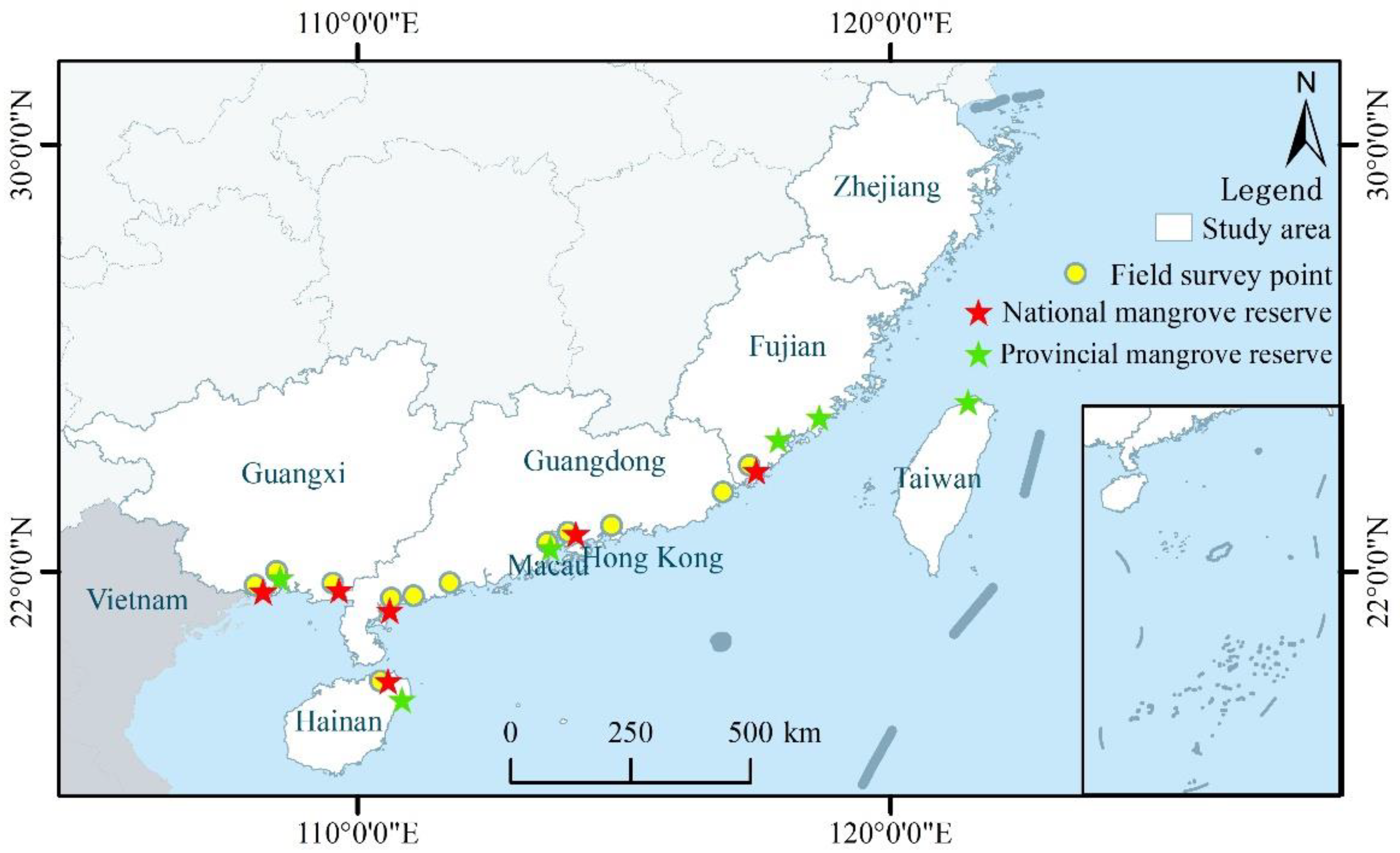


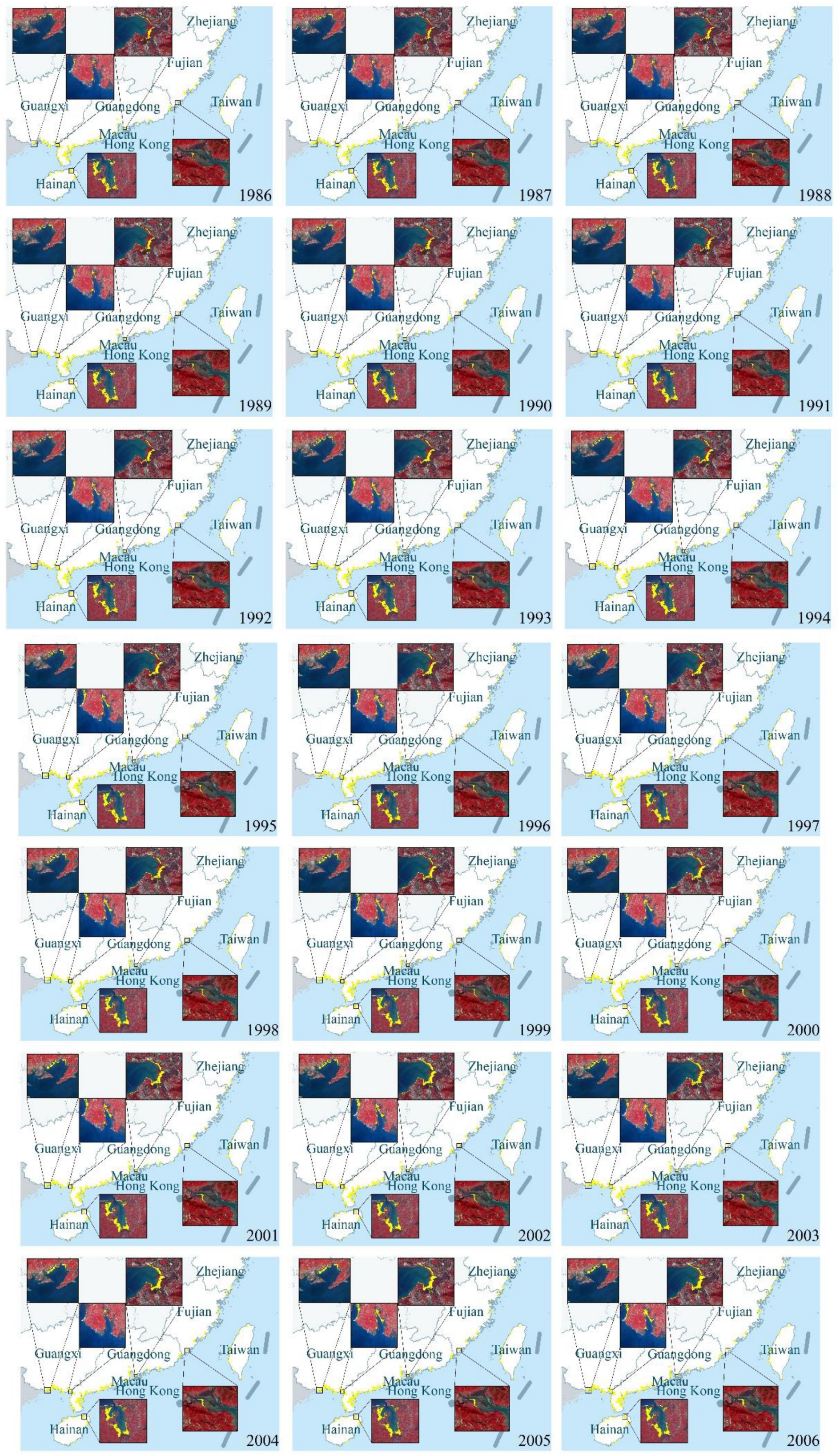
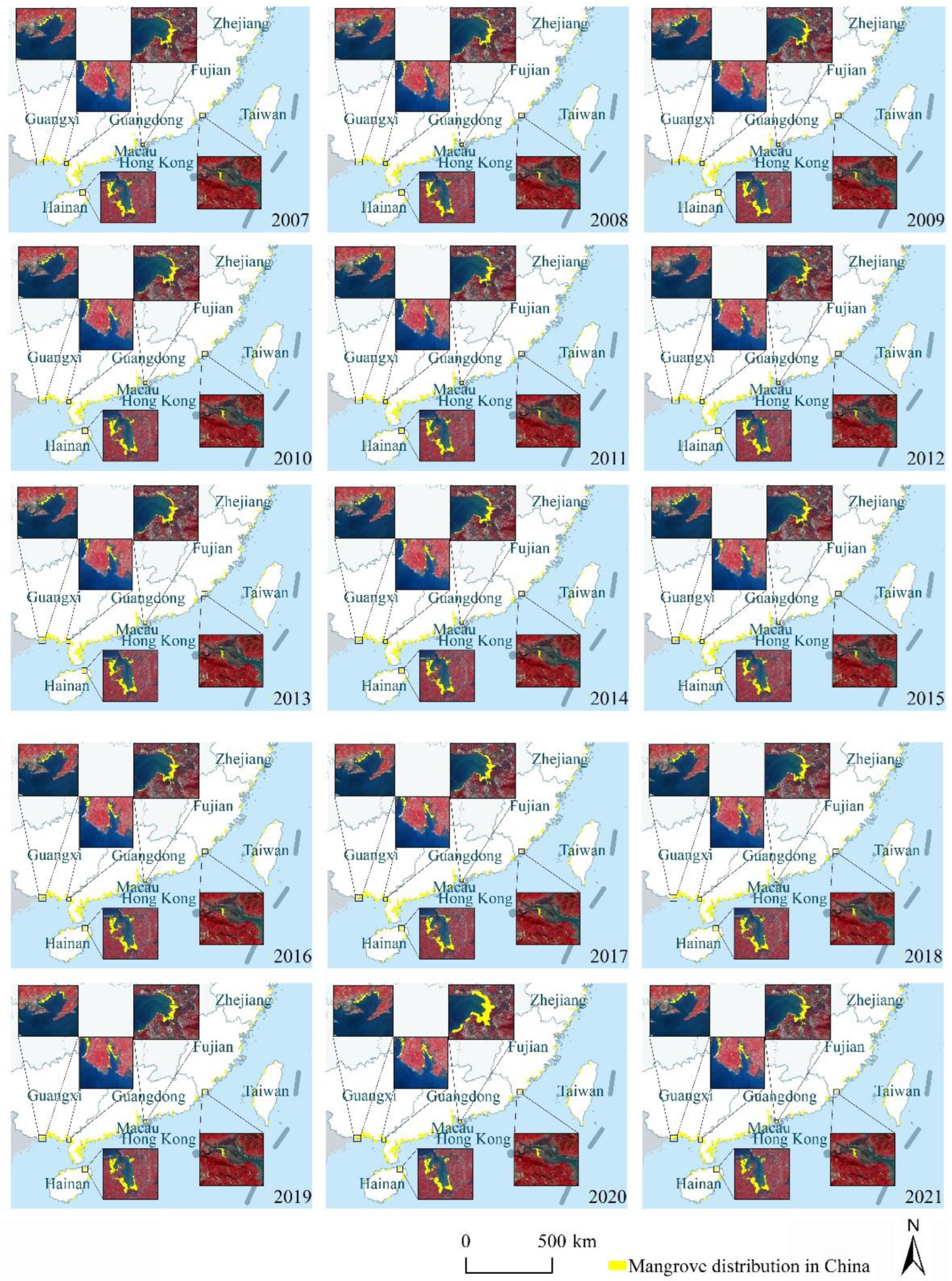




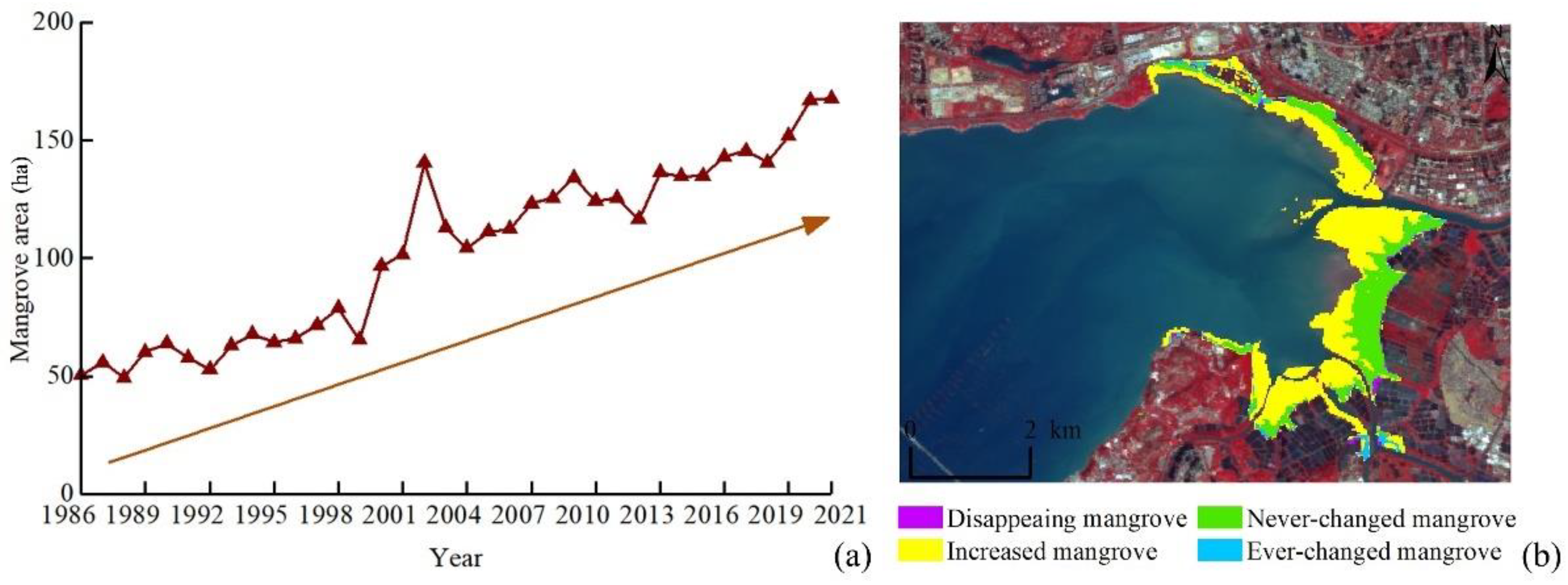
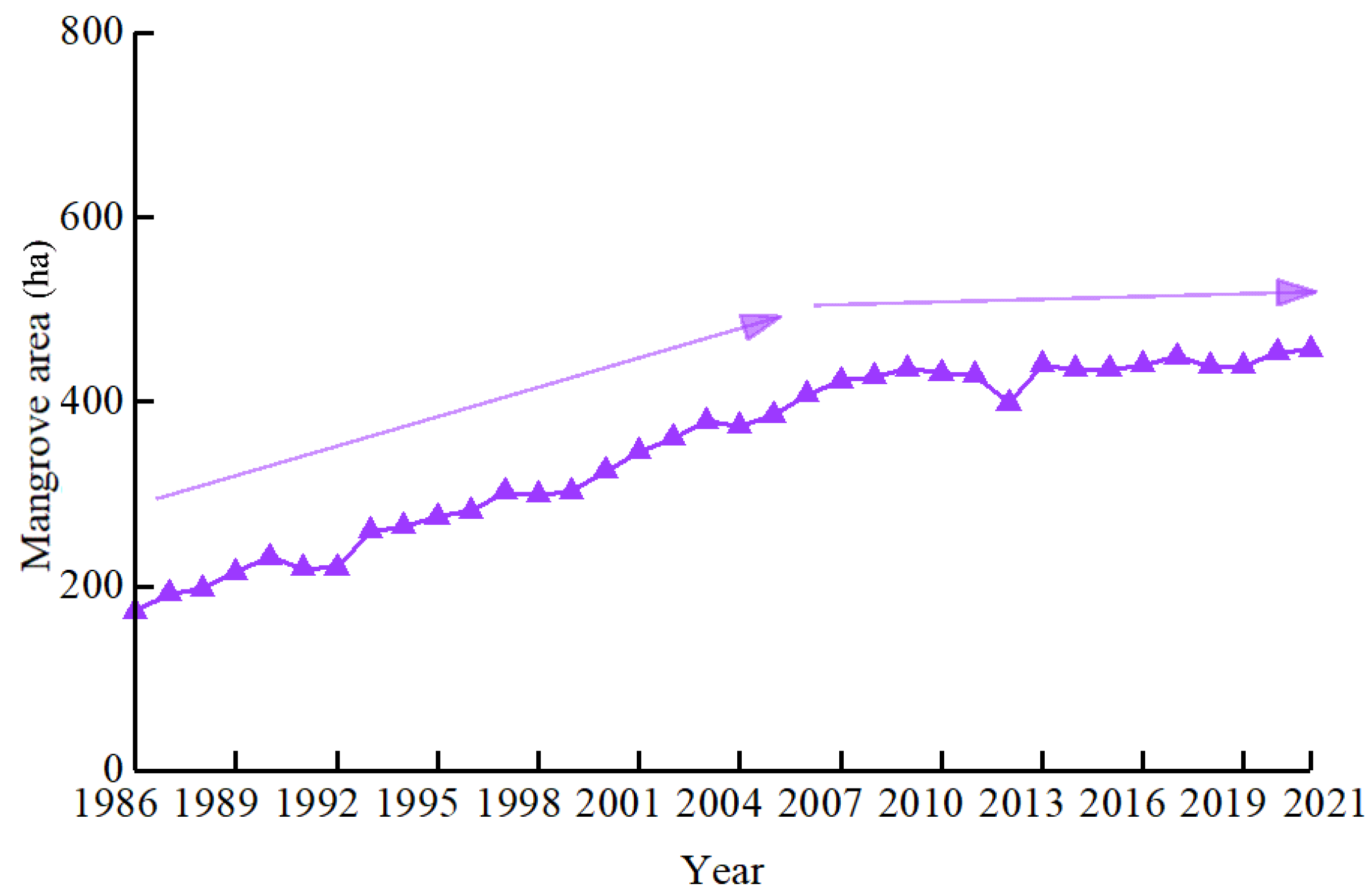
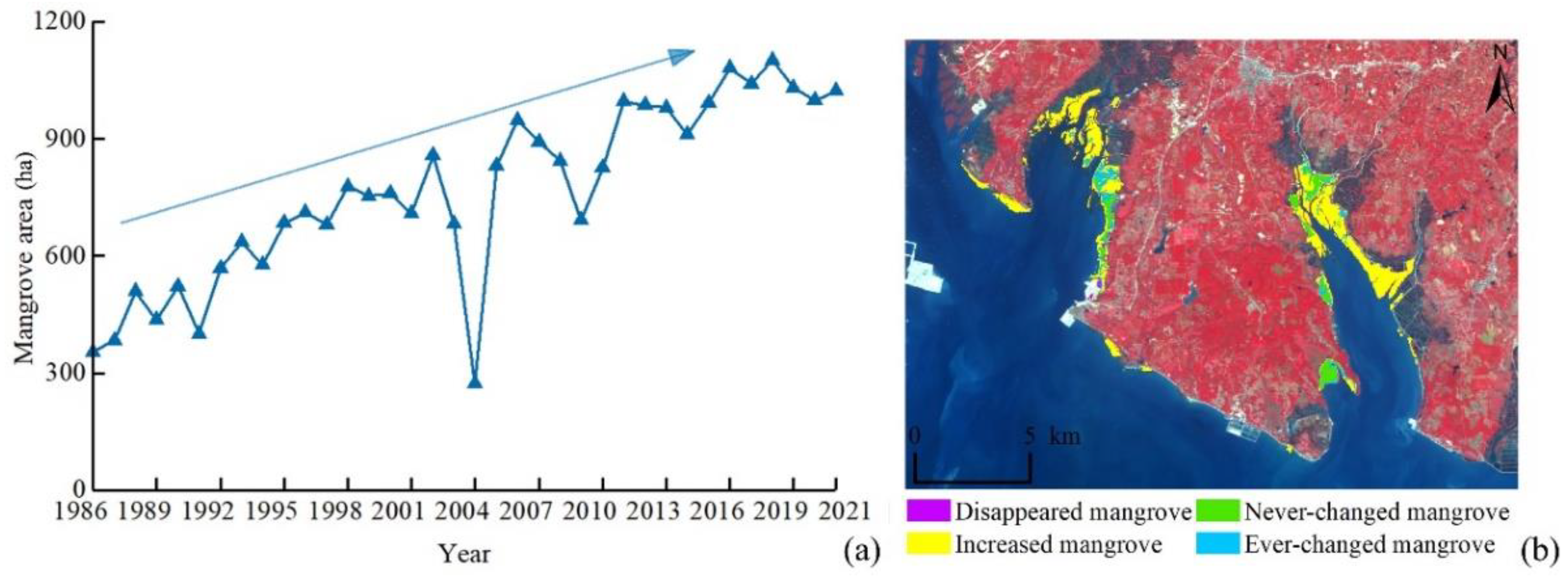
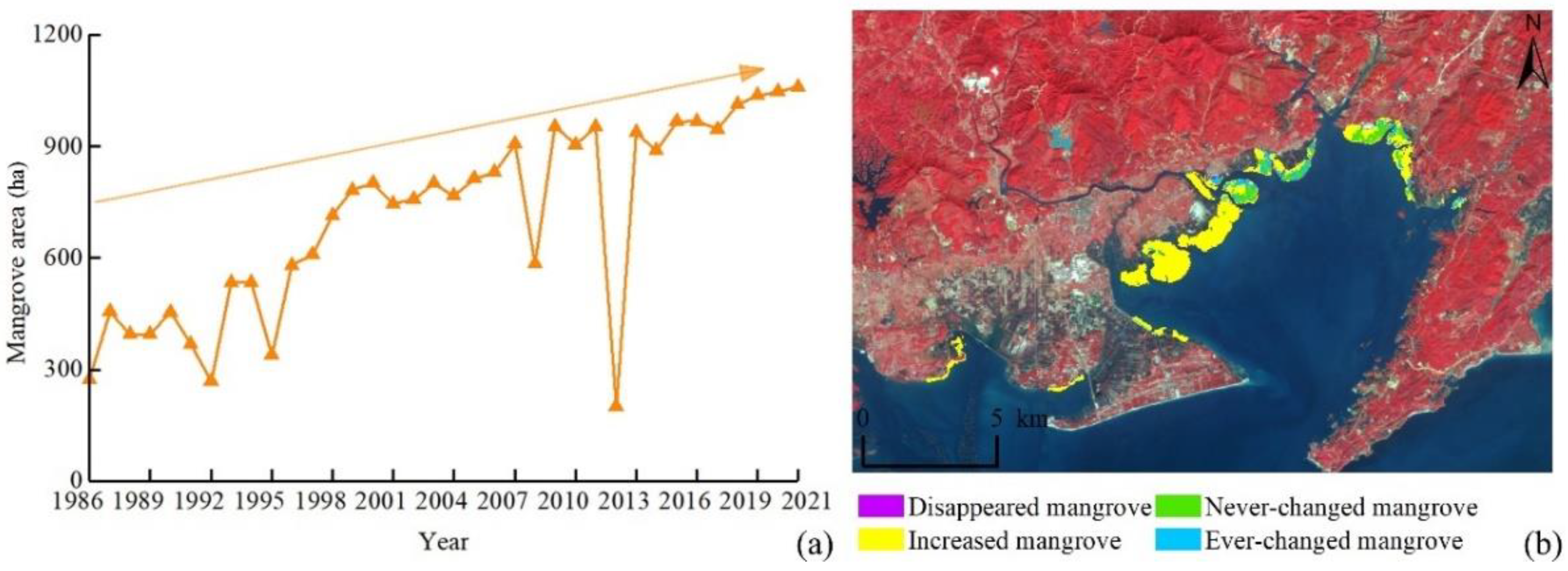
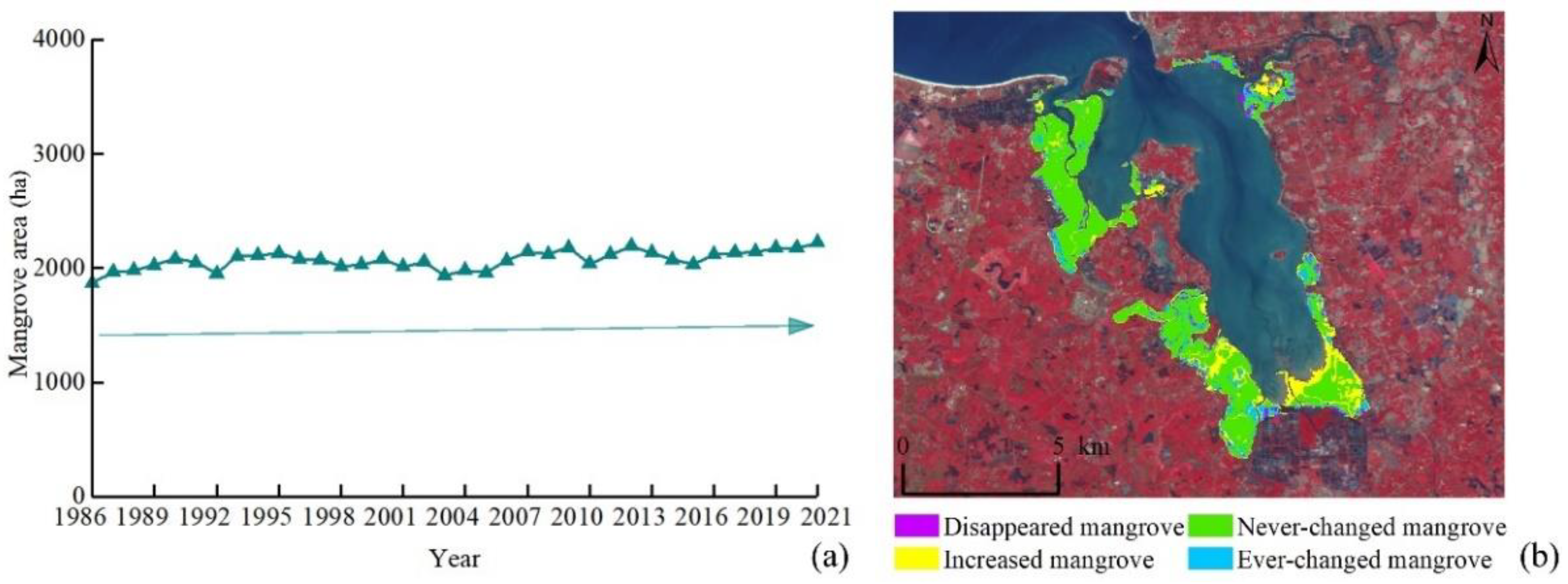
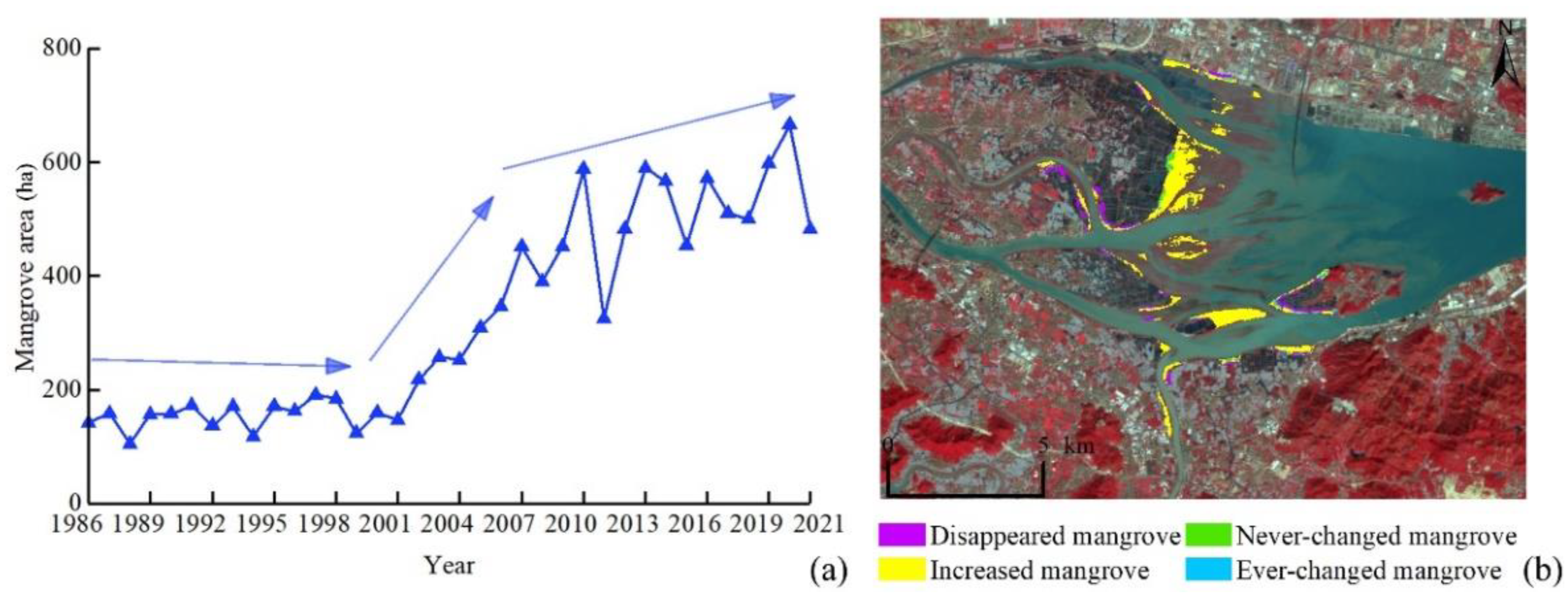
| Number of Mangrove Samples (pc) | Number of Non-Mangrove Samples (pc) | |
|---|---|---|
| Guangdong | 600 | 600 |
| Hong Kong | 80 | 30 |
| Guangxi | 600 | 400 |
| Fujian | 700 | 600 |
| Taiwan | 80 | 80 |
| Hainan | 600 | 600 |
| Zhejiang | 60 | 30 |
| Total | 2720 | 2340 |
| Category | Accuracy (%) | |
|---|---|---|
| User’s accuracy | Mangrove | 94.36 |
| Non-mangrove | 92.33 | |
| Producer’s accuracy | Mangrove | 92.95 |
| Non-mangrove | 93.85 |
| Year | Mangrove Area of This Study (ha) | Source (Previous Studies) | Mangrove Area of Previous Studies (ha) |
|---|---|---|---|
| 2015 | 23,455.67 | Jia et al. [12] | 22,494 |
| 2017 | 24,709.52 | Zhao et al. [28] | 21,148 |
| 2018 | 25,478.62 | Zhang et al. [17] | 25,683.88 |
| 2019 | 26,567.21 | Zhao et al. [16] | 27,053.07 |
| 2020 | 27,899.22 | Jia et al. [12] | 28,010 |
| Year | Area Change (ha) | Annual Change Rate (%) | Year | Area Change (ha) | Annual Change Rate (%) |
|---|---|---|---|---|---|
| 1986–1987 | 205.54 | 0.02 | 2004–2005 | 3603.21 | 0.26 |
| 1987–1988 | 206.87 | 0.02 | 2005–2006 | 922.72 | 0.05 |
| 1988–1989 | −591.34 | −0.05 | 2006–2007 | 1868.43 | 0.10 |
| 1989–1990 | 1064.37 | 0.10 | 2007–2008 | −2668.86 | −0.13 |
| 1990–1991 | −895.48 | −0.08 | 2008–2009 | 2630.52 | 0.15 |
| 1991–1992 | 303.88 | 0.03 | 2009–2010 | −183.09 | −0.01 |
| 1992–1993 | 1310.03 | 0.12 | 2010–2011 | 123.80 | 0.01 |
| 1993–1994 | 264.65 | 0.02 | 2011–2012 | −904.09 | −0.04 |
| 1994–1995 | 819.69 | 0.06 | 2012–2013 | 3433.97 | 0.18 |
| 1995–1996 | 812.76 | 0.06 | 2013–2014 | −612.63 | −0.03 |
| 1996–1997 | 1059.58 | 0.07 | 2014–2015 | 1194.65 | 0.05 |
| 1997–1998 | 30.09 | 0.00 | 2015–2016 | 1320.94 | 0.06 |
| 1998–1999 | −406.20 | −0.03 | 2016–2017 | −67.09 | 0.00 |
| 1999–2000 | 950.15 | 0.06 | 2017–2018 | 769.10 | 0.03 |
| 2000–2001 | −2305.35 | −0.14 | 2018-2019 | 1088.60 | 0.04 |
| 2001–2002 | 2372.97 | 0.17 | 2019–2020 | 1332.00 | 0.05 |
| 2002–2003 | −1093.30 | −0.07 | 2020–2021 | −472.00 | −0.02 |
| 2003–2004 | −897.16 | −0.06 | - | - | - |
Publisher’s Note: MDPI stays neutral with regard to jurisdictional claims in published maps and institutional affiliations. |
© 2022 by the authors. Licensee MDPI, Basel, Switzerland. This article is an open access article distributed under the terms and conditions of the Creative Commons Attribution (CC BY) license (https://creativecommons.org/licenses/by/4.0/).
Share and Cite
Wang, Z.; Liu, K.; Cao, J.; Peng, L.; Wen, X. Annual Change Analysis of Mangrove Forests in China during 1986–2021 Based on Google Earth Engine. Forests 2022, 13, 1489. https://doi.org/10.3390/f13091489
Wang Z, Liu K, Cao J, Peng L, Wen X. Annual Change Analysis of Mangrove Forests in China during 1986–2021 Based on Google Earth Engine. Forests. 2022; 13(9):1489. https://doi.org/10.3390/f13091489
Chicago/Turabian StyleWang, Ziyu, Kai Liu, Jingjing Cao, Liheng Peng, and Xin Wen. 2022. "Annual Change Analysis of Mangrove Forests in China during 1986–2021 Based on Google Earth Engine" Forests 13, no. 9: 1489. https://doi.org/10.3390/f13091489
APA StyleWang, Z., Liu, K., Cao, J., Peng, L., & Wen, X. (2022). Annual Change Analysis of Mangrove Forests in China during 1986–2021 Based on Google Earth Engine. Forests, 13(9), 1489. https://doi.org/10.3390/f13091489






